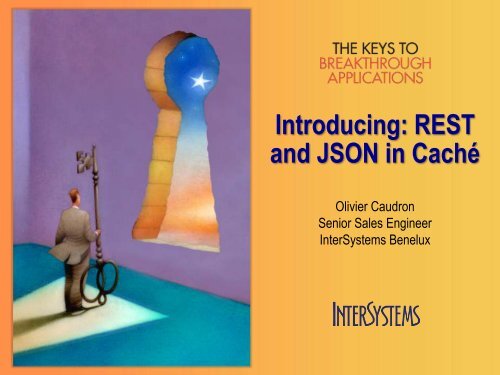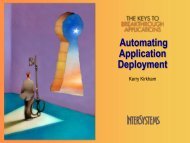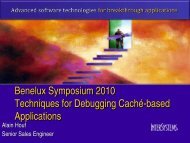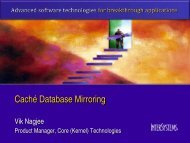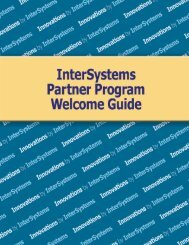Introducing: REST and JSON in Caché - InterSystems Benelux
Introducing: REST and JSON in Caché - InterSystems Benelux
Introducing: REST and JSON in Caché - InterSystems Benelux
You also want an ePaper? Increase the reach of your titles
YUMPU automatically turns print PDFs into web optimized ePapers that Google loves.
<strong>Introduc<strong>in</strong>g</strong>: <strong>REST</strong><br />
<strong>and</strong> <strong>JSON</strong> <strong>in</strong> Caché<br />
Olivier Caudron<br />
Senior Sales Eng<strong>in</strong>eer<br />
<strong>InterSystems</strong> <strong>Benelux</strong>
What is <strong>REST</strong>?<br />
• <strong>REST</strong> ("Representational State Transfer") is<br />
NOT a technology or "st<strong>and</strong>ard"<br />
• <strong>REST</strong> is a series of patterns, a set of pr<strong>in</strong>ciples,<br />
us<strong>in</strong>g the exist<strong>in</strong>g services of HTTP to express<br />
client queries to a server<br />
• It is a reaction to the complexity of RPC<br />
protocols like SOAP that defer functionalities to<br />
a higher layer (mostly <strong>in</strong> the SOAP "envelope")<br />
• http://en.wikipedia.org/wiki/<br />
Representational_state_transfer
Typical <strong>REST</strong>Ful Patterns<br />
• Use the HTTP "verbs" for CRUD operations:<br />
• HTTP POST == CREATE record(s)<br />
• HTTP GET == READ record(s)<br />
• HTTP PUT == UPDATE record(s)<br />
• HTTP DELETE == DELETE record(s)<br />
• Use the URL for identify<strong>in</strong>g resources<br />
• E.g. GET http://localhost/restapp/employee/1<br />
• The structure of the URL is not st<strong>and</strong>ardized <strong>in</strong> <strong>REST</strong>;<br />
it might also be:<br />
http://localthost/restapp?resource=employee&id=1<br />
or some other variant.
Uses of <strong>REST</strong><br />
• <strong>REST</strong> is ma<strong>in</strong>ly an architecture style for web<br />
*applications* (not relevant for *static* websites)<br />
• Can use <strong>REST</strong> as an alternative for SOAP/WS:<br />
• "<strong>REST</strong>Ful web services"<br />
• JUST an architecture style: NOTHING is st<strong>and</strong>ardized!!!<br />
• Object serialization is NOT def<strong>in</strong>ed (often use <strong>JSON</strong>)<br />
• Parameter pass<strong>in</strong>g is NOT st<strong>and</strong>ardized<br />
• Security is NOT def<strong>in</strong>ed <strong>in</strong> <strong>REST</strong><br />
• Transaction h<strong>and</strong>l<strong>in</strong>g, etc… ?<br />
• As long as it's not better st<strong>and</strong>ardized, not suitable<br />
for WS <strong>in</strong>teroperability IMHO
What is <strong>JSON</strong>?<br />
• <strong>JSON</strong> ("JavaScript Object Notation") is an<br />
object serialization system based on the<br />
JavaScript syntax<br />
• !!! Albeit very close, <strong>JSON</strong>'s notation is NOT identical<br />
to the JS syntax, there are significant differences !!!<br />
• However the contract is that the JS "eval" comm<strong>and</strong><br />
will be able to deserialize any <strong>JSON</strong> stream<br />
• <strong>JSON</strong>'s specification is very short (a onepager)<br />
<strong>and</strong> easy to underst<strong>and</strong><br />
• See http://www.ietf.org/rfc/rfc4627.txt or<br />
http://www.json.org/
<strong>JSON</strong> <strong>in</strong> a Nutshell<br />
• 2 base conta<strong>in</strong>ers: object <strong>and</strong> array<br />
• Array: [1,"foo","bar",3.141592]<br />
• Object: {foo:"bar",val:10}<br />
• Can be nested: arrays may conta<strong>in</strong> objects or arrays,<br />
<strong>and</strong> vice-versa, down several levels<br />
• Datatypes: object, array, str<strong>in</strong>g, number, boolean<br />
(true, false), null<br />
• Unlike JS, str<strong>in</strong>gs can only be enclosed <strong>in</strong> double quotes<br />
• Str<strong>in</strong>gs are unicode only<br />
• Character escape rules limited compared to JS
Uses for <strong>JSON</strong><br />
• Orig<strong>in</strong>ally, used to (de)serialize JS structures<br />
• Now used <strong>in</strong> <strong>in</strong>teroperability contexts where<br />
<strong>JSON</strong> is used between diverse OO systems<br />
• E.g. Javascript <strong>and</strong> PHP<br />
• <strong>JSON</strong> reflects the fact that JS is a prototypebased<br />
OO language, not a class-based OO<br />
language like Java, C++, Caché…<br />
• No metadata (classes), structures are completely<br />
dynamic need to def<strong>in</strong>e conventions between<br />
communicants on how to use the data!
Why <strong>JSON</strong>?<br />
• <strong>JSON</strong> is becom<strong>in</strong>g <strong>in</strong>creas<strong>in</strong>gly popular<br />
• May eventually completely replace XML (AJAX) for<br />
browser/server communications<br />
• MUCH simpler than XML (or others like EDI)<br />
• More human-readable than XML (most of the time)<br />
• MUCH more efficient to parse <strong>and</strong> serialize<br />
• Much more size-efficient than XML (but not EDI)<br />
• Better <strong>in</strong>tegration with Javascript
Downsides of <strong>JSON</strong><br />
• XML has many advantages over <strong>JSON</strong>:<br />
• Semantics & validation (DTD, XSD, WSDL, Schematron…)<br />
• Clear support for encod<strong>in</strong>g (lack<strong>in</strong>g <strong>in</strong> <strong>JSON</strong> –<br />
completely relies on convention)<br />
• Integration with RPC protocols (SOAP & WS)<br />
• Integration with security protocols beyond po<strong>in</strong>t-to-po<strong>in</strong>t<br />
(WS-Security, WS-Policy) <strong>and</strong> other services<br />
(WS-Transaction etc.)<br />
• IMHO, <strong>JSON</strong> w<strong>in</strong>s h<strong>and</strong>s down <strong>in</strong> the browser<br />
context but XML w<strong>in</strong>s h<strong>and</strong>s down <strong>in</strong> the web<br />
services context!
3 rd Party Support<br />
• The <strong>in</strong>creas<strong>in</strong>g popularity of <strong>JSON</strong> makes that<br />
it is very well supported by all sorts of tools:<br />
• HTML frameworks: JQuery, AngularJS, etc.<br />
• Server-side products: PHP <strong>and</strong> others, even<br />
databases<br />
• Some frameworks rely entirely on <strong>JSON</strong> <strong>and</strong><br />
provide a completely transparent<br />
serialization/deserialization (AngularJS)
Why <strong>REST</strong> <strong>and</strong> <strong>JSON</strong> <strong>in</strong> one Presentation?<br />
• <strong>REST</strong> is unrelated to <strong>JSON</strong> but requires some<br />
serialization technique for any serious work<br />
(could be XML)<br />
• <strong>JSON</strong> is unrelated to <strong>REST</strong> but needs some<br />
<strong>in</strong>teroperability technique (transport)<br />
• Nowadays, most <strong>REST</strong> projects use <strong>JSON</strong> as<br />
serialization mechanism<br />
• On the other h<strong>and</strong>, <strong>JSON</strong> is used a lot outside of<br />
the <strong>REST</strong> context (e.g. replacement for AJAX)
<strong>REST</strong> <strong>in</strong> Caché<br />
• <strong>REST</strong>Ful patterns can be used <strong>in</strong> any version<br />
of Caché us<strong>in</strong>g CSP (with some work)<br />
• …with the exception of some <strong>REST</strong>Ful URLs<br />
e.g. http://myserver/myapp/resource/id<br />
• To support those URLs, a change <strong>in</strong> the CSP<br />
application def<strong>in</strong>ition was required<br />
• Will be available <strong>in</strong> 2013.2, already stable<br />
• Further, we implemented an elegant<br />
dispatch<strong>in</strong>g mechanism for <strong>REST</strong>Ful requests<br />
• Note that <strong>REST</strong> is irrelevant to ZEN
Us<strong>in</strong>g <strong>REST</strong> <strong>in</strong> Caché 2013.2<br />
• Typically, you will create a second (or more)<br />
CSP application for a given namespace<br />
• Primary CSP application used to serve static <strong>and</strong> non-<br />
<strong>REST</strong>Ful pages<br />
• On this application, def<strong>in</strong>e<br />
a "dispatch class"<br />
• New sett<strong>in</strong>g<br />
• CSP file sett<strong>in</strong>gs <strong>and</strong> custom<br />
pages disabled: not relevant<br />
to <strong>REST</strong>Ful operations
Us<strong>in</strong>g <strong>REST</strong> <strong>in</strong> Caché 2013.2<br />
• The dispatch class is a class that <strong>in</strong>herits from<br />
%CSP.<strong>REST</strong> <strong>and</strong> def<strong>in</strong>es an xdata block UrlMap<br />
• Routes <strong>REST</strong>Ful URLs to classmethods<br />
• (<strong>REST</strong> is a stateless API: no <strong>in</strong>stance methods)<br />
• Declare the HTTP verb<br />
• Can pass parameters by prefix<strong>in</strong>g them with a colon
<strong>REST</strong> <strong>in</strong> Ensemble<br />
• A support exists <strong>in</strong> Ensemble for <strong>REST</strong>Ful<br />
communications (services <strong>and</strong> operations)<br />
• See the EnsLib.<strong>REST</strong> package or the<br />
Demo.<strong>REST</strong> package <strong>in</strong> the EnsDemo<br />
namespace
<strong>JSON</strong> <strong>in</strong> ZEN<br />
• Because of <strong>JSON</strong>'s efficiency <strong>and</strong> practicality,<br />
it is <strong>in</strong>creas<strong>in</strong>gly used <strong>in</strong> ZEN<br />
• Javascript notations are also <strong>in</strong>creas<strong>in</strong>gly used to<br />
def<strong>in</strong>e contents or structure for components (e.g.<br />
navigator, f<strong>in</strong>derPane…)<br />
• To feed a <strong>JSON</strong>-aware component, use one<br />
of the json providers: jsonProvider,<br />
jsonSQLProvider or jsonArrayProvider<br />
• Invisible component added to the ZEN page def<strong>in</strong>ition<br />
• L<strong>in</strong>k via ControllerId attribute of component
<strong>JSON</strong> <strong>in</strong> CSP<br />
• In Caché 2013.1, <strong>JSON</strong> serialization/deserialization<br />
methods have been made public <strong>and</strong> can be used<br />
outside of ZEN<br />
• Can be an alternative to #SERVER()# <strong>and</strong><br />
#CALL()# <strong>in</strong> CSP, possibly with <strong>REST</strong> (2013.2)<br />
• <strong>JSON</strong> is not as well-<strong>in</strong>tegrated to CSP as hyperevents<br />
• …but can be <strong>in</strong>terest<strong>in</strong>g to use with <strong>JSON</strong>-enabled 3 rd<br />
party frameworks (e.g. JQuery, AngularJS)<br />
• Could possibly be used <strong>in</strong> other contexts, e.g. to<br />
communicate between PHP <strong>and</strong> Caché
DEMO
<strong>Introduc<strong>in</strong>g</strong>: <strong>REST</strong><br />
<strong>and</strong> <strong>JSON</strong> <strong>in</strong> Caché<br />
Olivier Caudron<br />
Senior Sales Eng<strong>in</strong>eer<br />
<strong>InterSystems</strong> <strong>Benelux</strong>


